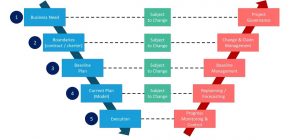Change Control: 4 Levels of Change
Gert Truyens explains what the different levels of change are, what they mean and how you can deal with them.
Managing change will always be a challenge in projects. Its importance cannot be overestimated in order to successfully deliver projects. Messing up will have huge implications in a claim-oriented environment. Still we see many project teams struggling with organizing and following a proper change management process.
A first step which proved to be of great help, is differentiating between several levels of change. To do this, we start by defining 5 levels on which projects are managed.
5 Levels of managing projects
Project team members and corporate management deal with different levels of management.
- A project is stemmed by a business need from the parental organization, i.e. the why of the project. Corporate management must guard the alignment of the project with the company, or in other words: the existing organization’s governance should be supported by the project governance.
- The project charter is on the second level: it delimits the scope, objectives and responsibilities of the project mandate. These are translated into the boundaries of the project contract: contractual scope, milestones and price. The Contractor must execute the project within these boundaries. At this level a funding reserve (both time and budget) may be available to cover the project owner risks. Exceeding the boundaries may lead to variation orders.
- Within those contractual boundaries, a project baseline is set. This is the agreed plan to execute the project and monitor progress against a set baseline scope, schedule and cost. It is the responsibility of the PM to deliver the project within the boundaries of this baseline. Where at level 2 it is the project owner that owns the funding reserve, similarly at level 3 e.g. the project board owns the management reserve which covers unknown unknowns. Eventual exceedances of the baseline can lead to baseline updates.
- Based on monitored progress, the project should have at any time a current plan including a new forecast of the remaining activities, i.e. the estimate at completion. At this level, the PM has the contingency reserve at his disposal to cover project risks. Deviations from the current plan are variances and might require preventive and corrective actions.
- At the lowest level, smaller activity level deviations are monitored. I like to call this the executional or operational level where deviations don’t require replanning. At this level, you accept that the work cannot be executed exactly according to plan, minute by minute. You measure, monitor and report progress resulting in the actual schedule and actual costs.
4 Levels of change
When a change is identified, understanding the type or level of change you are dealing with is a first step that will greatly help you structuring the change management process. It is the association with one of the levels of project management that will help you categorizing changes. This in its turn will than guide the team in dealing with the change. In the model below (Figure 1: 4 levels of change), you can see that levels 1 to 4 are subject to change.
At the 5th level, we only talk about ‘events’ and not change: it’s merely the daily progress monitoring and control process. However, those events can lead to change on a higher level. In general, higher level changes will impact all lower levels, and lower level changes might or might not lead to changes at higher levels.

Fig.1 – 4 levels of change
- Change at level one is related to an update of the business case. For example, changing the type of contract or the subject of the contract (a bridge is changed to a tunnel to state an extreme example). This type of change will impact all other levels as well.
- A level two change would require changes to the project boundaries, which are often amendments to the contract. Variation orders would resort under this category (for example scope changes), but also a change of a contractual milestone is a typical level two change.
- Changes at level three would entail baseline updates of the current project scope, meaning that here you stay within the project boundaries (hence the difference between level two and three). A typical example here is a variation order at level 2 that leads to a baseline update at level 3. Also in an Earned Value Management context, a management reserve transaction would typically update the baseline, without affecting the boundaries and is thus a level three change.
- Deviating from the plan usually doesn’t initiate a baseline change. At level four, a change can lead to replanning of the remaining work by taking mitigation measures. For example, resequencing some activities to accelerate completion would occur at this level.
Conclusion
Being aware of the level at which a change occurs is a crucial step to start the change control process with. How you deal with changes is highly dependent on the level. If you want to become the expert in this field or you can use some guidance at your current project, Primaned’s “Change Control and Claim Analysis” training might be just what you need.



